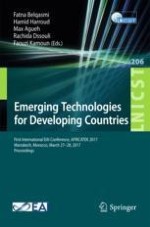2018 | Buch
Emerging Technologies for Developing Countries
First International EAI Conference, AFRICATEK 2017, Marrakech, Morocco, March 27-28, 2017 Proceedings
herausgegeben von: Dr. Fatna Belqasmi, Hamid Harroud, Max Agueh, Rachida Dssouli, Faouzi Kamoun
Verlag: Springer International Publishing
Buchreihe : Lecture Notes of the Institute for Computer Sciences, Social Informatics and Telecommunications Engineering
